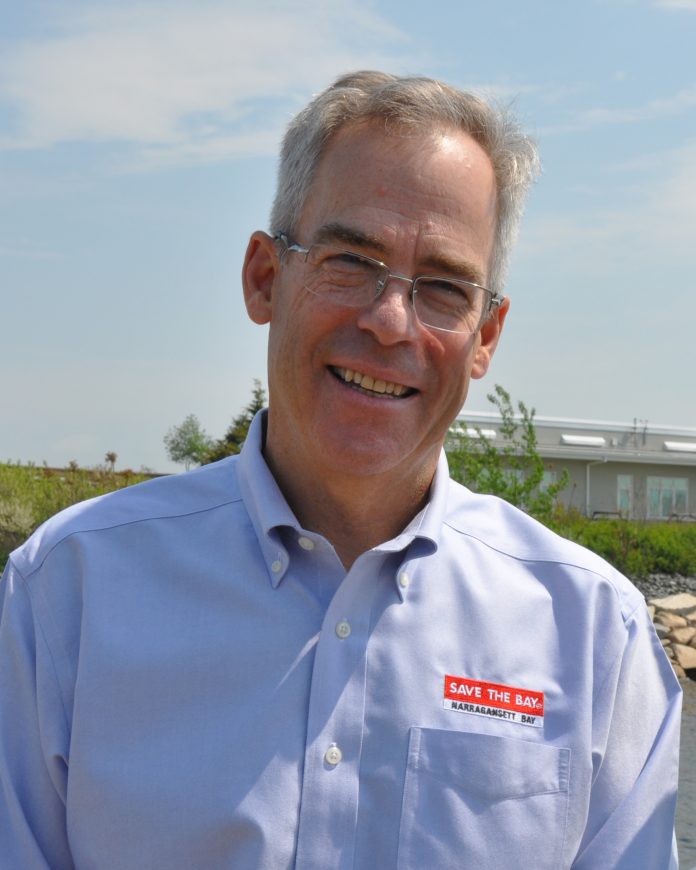On Saturday, July 27, Save The Bay Inc. Executive Director Jonathan Stone will join about 400 other swimmers and kayakers for the annual Save The Bay Swim, a 1.7-mile journey across the East Passage of Narragansett Bay, from Newport to Jamestown.
For 43 years, the annual swim has been a major fundraiser for the nonprofit, and it takes 250 volunteers to make it happen. People can participate as swimmers, kayakers or volunteer. Visit savebay.org/swim for more information.
PBN: How did the Save The Bay Swim get its start and was it intended from the beginning to be an annual fundraiser for the organization?
STONE: The first swim, in 1977, was the brainchild of Trudy Coxe, who was working under our first executive director, John Scanlon, at the time. No one had ever done a cross-bay swim, at least not in a formal, organized way. Trudy knew it would be a great way to highlight the value of the bay, to create public awareness around the bay.
Mind you, this was at a time when many people with power and influence argued that the best use of the bay was as a place for industry, including refineries, power plants, polluting factories and sewage plants.
Trudy and John thought they’d be lucky to get 20 swimmers; within a couple of weeks, 100 swimmers had signed up. The very first swimmer who signed up that year, Edgar Mercado, is still participating in the swim today.
PBN: How big a part does the swim play in the Save The Bay’s fundraising efforts? Typically, how much is raised?
STONE: The swim has become Save The Bay’s signature event, raising awareness and generating the funds necessary to sustain our advocacy, marine education and habitat restoration work.
Swimmers do the swim not only for the recreational fun and personal challenge of it, but also to make a statement that Narragansett Bay is important to Rhode Island and to them personally, worth protecting and investing in.
Every swimmer raises at least $400 from friends and family; and many businesses, large and small, contribute to the cause as sponsors. In total, the swim raises about $275,000, or nearly 10% of our annual operating budget.
PBN: It’s been said that in that first swim, participants were avoiding oil and tar balls in the bay. What are the conditions swimmers face nowadays? Is the cleanliness of the water where Save The Bay would like it to be?
STONE: Funny story: That first year, 1977, a few days before the swim, R.I. Department of Health notified Trudy that the water at the Jamestown starting line was not fit for human contact. So, Trudy had to announce that news at the start of the swim and direct everyone to climb into their rowboats and paddle out some 300 yards before the water was clean enough to swim in. At the time, there couldn’t have been a more poignant message about the need for Save The Bay.
We have testimonies from swimmers who remember the years of tar balls and oil slicks on their wetsuits after the swim. I’ve been doing the swim for 15 years, and I’m delighted to report that I’ve seen schools of menhaden swimming beneath me and plowed through millions of crab larvae as I cross the East Passage.
There is no question that the cleanup of Narragansett Bay is a national success story. But water quality conditions, both in the East Passage and many other areas of the bay, are routinely degraded by stormwater runoff, sewage overflows, algal blooms, low oxygen conditions and declining habitat quality. Climate change, demands for coastal development, and waning commitment by local and state government is compounding the problems we regularly observe.
PBN: Where do the swimmers come from? Beyond Rhode Island? Is it true that some participants have done “virtual” swims in other parts of the world to benefit Save The Bay?
STONE: Over the years we have had swimmers from nearly 30 states, including Hawaii, and we occasionally have swimmers from abroad. We also have the support of virtual swimmers who can’t make it back to Rhode Island or are unable to complete the swim due to schedule or health reasons but want to support the swim and Save The Bay. They register, they do the fundraising, they measure out the 1.7 nautical miles wherever they are, and they do the swim – sometimes in a swimming pool in another state, sometimes in the Italian countryside.
When weather in 2017 forced us to cancel the swim, many swimmers used social media to begin their own virtual swim efforts, and that spurred us to make it a formal thing that year. We are grateful to those swimmers who forged ahead on their own and helped us raise the critical funds we rely upon each year.
PBN: What new/different features of the swim might participants see this year? Are there any donors offering matching contributions?
STONE: Three things:
First, we are delighted to welcome back Olympic swimmer Elizabeth Beisel as our community Save The Bay Swim ambassador for the second year. This year, she held a youth swim clinic and is now using our social media platforms to share swim training tips. She’s set a very high fundraising goal for herself and will swim alongside our swimmers on July 27.
Second, we’ve started a Save The Bay Swim Scholarship for first-time swimmers ages 15-21, to help offset their fundraising commitment and make sure that swimmers of all ages have the chance to experience one of the most amazing open-water swims in the country.
Last but not least, we have received a generous matching challenge from longtime swimmer and former CEO of Citizens Bank, Larry Fish. As part of our 50th Anniversary Campaign, Larry has challenged us to increase overall donations from the swim. He has offered to match, up to $25,000, any increase in total donations raised by swimmers over last year.
Even community members who don’t swim a stroke can help us meet Larry’s challenge by sponsoring a swimmer – even someone they don’t know – or a team, by supporting the swim itself, or by making a contribution to the Swim Scholarship fund. They can do all of this on our website at savebay.org/support-the-swim.
William Hamilton is PBN staff writer and special projects editor. You can follow him on Twitter @waham or email him at hamilton@pbn.com.













